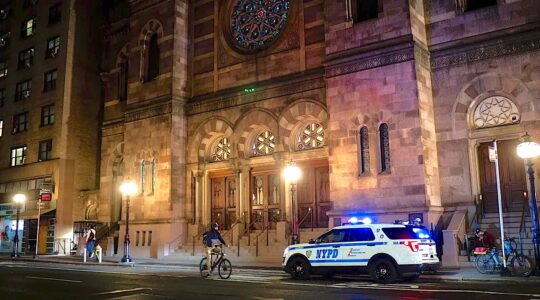One of the most picturesque and creative festivals of the year is Sukkot, when the entire family is involved in building and decorating a special “nature home” that will be lived in for an entire week.
But what are we actually celebrating and what is the true meaning of the sukkah? Is it the sukkah that the Israelites constructed in their desert wanderings? If so, then the sukkah becomes a reminder of all of the exiles of Israel throughout our history, and our thanksgiving to God is for the fact that we have survived despite our fragility, persecution and pogroms.
Or is the sukkah meant to be reminiscent of the Divine “Clouds of Glory” that encompassed us in the desert with God’s rays of splendor, with the Sanctuary serving as the forerunner of our Holy Temple? In the Grace After Meals during Sukkot we pray that “the Merciful One restore for us the fallen sukkah of David,” which would certainly imply that the sukkah symbolizes the Holy Temple. The Talmud [Sukkot 11] presents a difference between Rabbis Akiva and Eliezer as to which of these options is the true significance of Sukkot.
The major biblical description of the festivals is found in Leviticus 23. Our three national festivals are Pesach, Shavuot and Sukkot, commemorating the leaving of Egypt, receiving the Torah, and living in the desert. Rosh HaShanah and Yom Kippur are more universal, not at all related to the desert sojourn. It seems strange that in the biblical exposition of the calendar, Pesach and Shavuot are first explained, then Rosh HaShanah and Yom Kippur, and only at the conclusion of that description comes Sukkot.
Now, of course, one can argue that this is the way the months fall out on the calendar. However, that too raises questions. After all, the Israelites left Egypt for the desert (Pesach); presumably built their booths (Sukkot); and then received the Torah (Shavuot). Would it not have been more logical for the order of the holidays to be Pesach, Sukkot, Shavuot and then Rosh HaShanah and Yom Kippur?
Secondly, Sukkot is broken up into two parts. Initially, the Torah tells us: “And [God] spoke to Moses saying: on the 15th day of this seventh month shall be the Festival of Sukkot, seven days for God, holy convocations” [Lev. 23:33-38]. It would seem that these last words conclude the biblical description of the desert festivals. But then, in the very next verse, the Torah comes back again to Sukkot, as if for the first time: “But on the 15th day of the seventh month, when you gather in the crop of the land, you shall celebrate God’s festival for a seven-day period. … You shall take for yourselves on the first day the fruit of a citron [etrog] tree, the branches of a date palm [lulav], twigs of [a myrtle, the hadass] and willows of brooks [the aravah]” — the Arba Minim, or the Four Species — “and you shall rejoice before the Lord your God for a seven-day period. … You shall dwell in booths for a seven-day period … so that your generations will know that I caused the people of Israel to dwell in booths when I took them from the Land of Egypt. I am the Lord your God” [Lev. 23:39-44]. Why the repetition? And if the Bible now wishes to tell us about the Arba Minim (which we are to wave in all directions in thanksgiving to God for his agricultural bounty), why was this verse not linked to the previous discussion of Sukkot? And why repeat the booths again?
I have heard it said in the name of the Vilna Gaon that this repetition of Sukkot with the commandment concerning the Arba Minim is introducing an entirely new aspect of the Sukkot festival: the celebration of our entering into the Land of Israel. Indeed, Rambam explains the great joy of Sukkot as expressing the transition of the Israelites from the arid desert to a place of trees, rivers, fruits and vegetables, as symbolized by the Four Species [Guide for the Perplexed, Part 3 Chapter 43]. In fact, this second Sukkot segment opens with the words, “But on the 15th day of the seventh month when you gather the crop of the Land [of Israel], you shall celebrate this festival to the Lord.”
Hence, there are two identities to Sukkot. On the one hand, it is a desert festival celebrating our desert wanderings and survivals while living in flimsy booths. From that perspective, perhaps it ought to have found its place immediately after Pesach in terms of the calendar and certainly before Rosh HaShanah and Yom Kippur in the biblical text. However, the second identity of Sukkot, relating to the Four Species, representing our conquest and inhabitancy of our homeland, signals the beginning of redemption, and so it belongs after Rosh HaShanah and Yom Kippur (the festivals of God’s kingship over the world), and His Holy Temple, “a House of Prayer for all the nations.” This second aspect of Sukkot turns the sukkah into the rays of Divine splendor and an expression of the Temple.
So which Sukkot do we celebrate? Both at the very same time! But when we sit in the sukkah, are we sitting in transitory booths representative of our wandering, or in a Divine Sanctuary protected by the rays of God’s glory?
I think it depends on whether we are celebrating Sukkot in the diaspora or in the Land of Israel.
Rabbi Shlomo Riskin is chancellor of Ohr Torah Stone and chief rabbi of Efrat.
Candlelighting, Readings:
Support the New York Jewish Week
Our nonprofit newsroom depends on readers like you. Make a donation now to support independent Jewish journalism in New York.
Candles: 5:53 p.m. (Fri.); 5:50 p.m. (Sun.); 6:48 p.m. (Mon.)
Torah: Exodus 33:12-34:26;
Numbers 29:26-34
Haftarah: Ezekiel 38:18-39:16
Havdalah: 6:52 (Sat.); 6:47 p.m. (Wed.)
The New York Jewish Week brings you the stories behind the headlines, keeping you connected to Jewish life in New York. Help sustain the reporting you trust by donating today.




